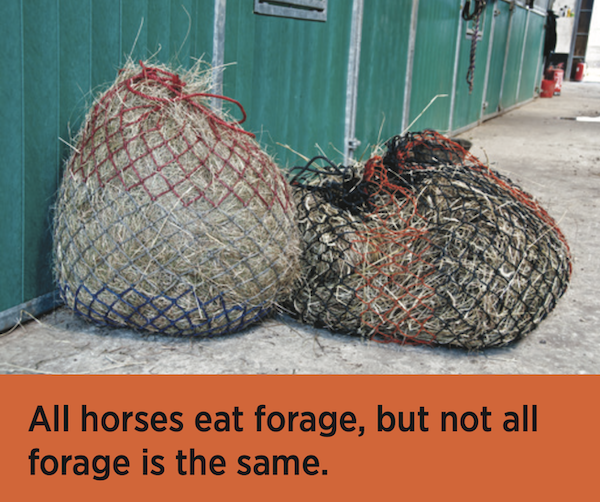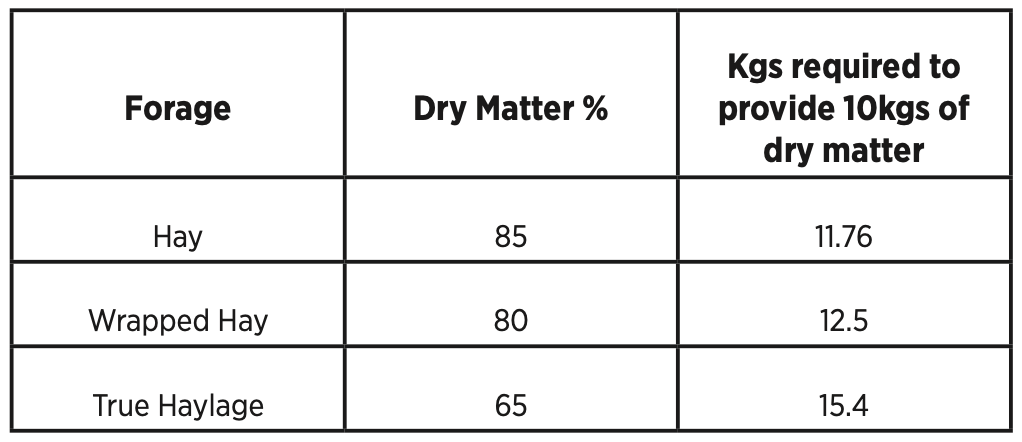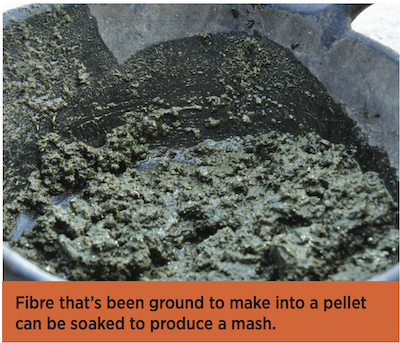Fibre for All
By Tracey Hammond M.Sc (Dist), Equine Nutritionist at Dengie Horse Feeds

AMTRA is required by the Veterinary Medicines Regulations to ensure its RAMAs/SQPs undertake CPD. All RAMAs/SQPs must earn a certain number of CPD points in a given period of time in order to retain their qualification. RAMAs/SQPs who read this feature and submit correct answers to the questions below will receive two CPD points. For more about AMTRA and becoming a RAMA/SQP, visit www.amtra.org.uk
Horses have evolved to eat forages which can be loosely defined as plants either in a fresh form or conserved that are relatively high in fibre.
While all horses eat forage, not all forage is the same and neither are the requirements of the horses and ponies that eat it. An individual’s needs will vary according to the amount and type of work they are doing, their body weight and body fat score as well as factors such as the condition of their teeth.
It is important that we choose the right forage for the right horse as it should make up a significant proportion of the total ration and therefore is often likely to have a bigger impact on the horse than other elements of the diet.
FORAGE SUPPLIES FIBRE
Fibre is vital for the health of the horse’s digestive tract; forage, either as fresh pasture or conserved to make hay or haylage, is the main source of fibre in most horses’ rations.
While we don’t know the horse’s exact fibre requirements, it is generally accepted that 1.5% of bodyweight on a dry matter basis should be fed as forage daily (Harris et al., 2017). For a 500kg horse this equates to 7.5kg dry matter daily which is 8.8kg of hay as fed if the hay is 85% dry matter, or 11.5kg of haylage if it is 65% dry matter.
Feeding below these levels has been linked to digestive problems such as gastric ulcers, loose droppings and colic. The variable that can be changed is the type of forage and this is where selecting the right forage is really important for factors such as respiratory health, weight management and sugar intake.

HOW CAN WE TELL WHAT A FORAGE PROVIDES?
The only way of knowing the nutritional contribution of a forage to the ration is through analysis.
The highly variable nature of nutrient levels in grass both throughout the day and the seasons, combined with the challenges of maintaining the quality of pasture samples whilst shipping them to the lab, means it is more common to test conserved forages like hay and haylage.
Lots of reference values exist for pasture and if there is a concern about a particular mineral, it is possible to test the soil to establish possible deficiencies as plants tend to reflect the soils they are grown on.
There are two main options for forage analysis offered by laboratories in the UK: NIR or Wet Chemistry. Near Infrared Reflectance Spectroscopy (NIR) determines the chemical composition of the forage by measuring light energy that is reflected by the sample and comparing it to calibrated reference ranges. Large amounts of Wet Chemistry analysis must be performed to calibrate NIR equipment and for this reason this analysis is best suited to common forages including grass hay, wrapped hay and haylage to produce accurate results. NIR is a cost-effective method that gives a good overview of the key nutrients provided by the forage.
Wet Chemistry is a more appropriate analysis technique to use for soaked hays or forages that are not conserved grass such as straw if the calibration for the NIR is not available. Some forage analysis tests including water soluble carbohydrate (WSC), starch and minerals are only available using wet chemistry. Unlike NIR, Wet Chemistry is a longer analytical process requiring a larger amount of equipment and chemicals and therefore is more costly.
At a very basic level, analysing forage gives us key information that links to how much to feed when comparing forages of different dry matters. Many people are confused by the differences between hay and haylage. As a true haylage contains more moisture than hay, you need to feed more haylage in order to provide sufficient fibre in the ration. There are also many drier haylages that have a dry matter much closer to hay – referred to as wrapped hay as they don’t contain enough moisture to properly ferment in the way a true haylage would.
To illustrate the importance of knowing the dry matter of a forage the following table shows the different quantities required of each forage to provide 10kgs of dry matter:

To calculate the amount to feed ‘as fed’ simply divide the amount of dry matter required by the horse by the fraction of the percentage of dry matter e.g. for hay 10kgs dry matter required divided by 0.85 as the hay is 85% dry matter 10/0.85=11.76kgs need to be fed.
FIBRE FOR THE PERFORMANCE HORSE
Digestibility is key when determining the usefulness of a forage for the performance horse. The more digestible the forage, the more digestible energy it provides.
The digestibility of a forage is determined by the type of plant and most significantly the age of the plant at the time of harvest. The older and taller a plant becomes, the more lignin is present, which is why hay is less digestible than a true haylage that has been harvested when the grass is younger for example.
Lignin is an indigestible substance that gives a plant structure. Lignin binds cellulose and hemi-cellulose, which are types of fibre that are fermented in the horse’s gut for energy, significantly reducing the digestibility of the forage.
Another substance found in plant cell walls is pectin. This isn’t linked to lignin and so remains completely available for fermentation and so is very digestible. While grass tends to contain lower levels of pectin other feeds commonly found in the bucket such as sugar beet, alfalfa and soya hulls are much higher and can make a significant contribution.
Forages of this quality can be used to fuel hard levels of work too. Sadly, it is still suggested that performance horses need high levels of cereal based feeds to be able to perform despite studies showing that high quality forages can be sufficient. Standardbred trotters fed a high-quality forage diet performed at a comparable level to those fed a typical concentrate diet (Jansson & Lindberg 2012).
Beyond digestibility, the hygienic quality of the forage is also vital for the performance horse to support their respiratory health. As well as being more digestible, a true haylage also contains less respirable particles than hay due to the preservation process from the retention of moisture and exclusion of oxygen when baling.
Haylage compared with dry hay is therefore a ‘cleaner’ forage source, although the hygienic quality of hay can be improved with steaming.
FIBRE FOR THE OVERWEIGHT, LAMINITIS PRONE HORSE
UK pasture and forage can easily oversupply calories for leisure horses and ponies in light to moderate work. Many UK horse owners are therefore battling to keep their horses at a healthy weight.
Grass is a particular problem and can supply more than double the energy requirements of horses in light work at certain times of the year such as the spring and early summer, so action must be taken to limit intake via strip grazing or the use of a muzzle for example.
The forage needs of the overweight horse are opposite to the performance horse as they require less digestible sources of fibre. Forage that feels coarse and stalky that is late cut is more useful for these individuals and managing their waistlines.
Straw contains high levels of lignin and is therefore even less digestible and therefore lower calorie than late cut hay. It is suggested that straw can be fed at up to 30% of the total forage ration (Harris et al., 2017), providing it is introduced gradually into the diet and that the horse has no dental problems.
As well as reducing the overall energy intake, mixing straw into the forage ration may also have the practical advantage of increasing eating time as horses pick out the forage they find tastiest first before eating the straw.
For owners of overweight horses and good do-ers that are also laminitis-prone it is not just the calories that are of concern. The level of water-soluble carbohydrate (WSC) in forage is particularly important as well as for those with Insulin Resistance/Equine Metabolic Syndrome and PPID (Cushing’s). NSC, which stands for non-structural carbohydrates, is the sum of WSC and starch added together and is determined by Wet Chemistry Analysis.
Current recommendations for the management of laminitis prone horses, those with IR/EMS and PPID (Cushing’s) horses are to try to feed forage or feeds with less than 10-12% NSC on a dry matter basis. These figures are primarily based on personal observations and experiences rather than specific scientific studies to show that these levels are ‘safe’ but are a good guide to aim for.
In practice, all horses are individuals and the severity of the metabolic issues that they have will vary and therefore influence which forages will work for them.
The level of WSC in hay directly relates to the level of WSC in grass at the time of cutting. For example, the level of WSC in forage will be higher when cut in the afternoon compared to that cut earlier in the morning. The level of WSC is also lower on a cloudy day compared with a sunny one.
The type of grass in the forage will also influence the level of WSC, with ryegrass typically, although not always, having a higher level compared with timothy for example.
As can be seen, the factors affecting the levels of WSC in grass and therefore forage is complex and not easy to predict. Therefore analysis is key to determining the suitability of forages for horses with these issues.
FIBRE FOR THOSE WITH COMPROMISED DENTITION
While dental issues can occur in horses of any age, they are most commonly associated with older horses as their teeth can become worn and loose, a problem that is usually first noticed when a horse drops partially chewed feed from its mouth which is termed “quidding”.
Horses that quid long stem forage like hay or haylage can be problematic. If they consume less forage, they may lose weight and if they start to swallow larger pieces of forage, an impaction may occur. Forages for older horses should take account of this and may need to be softer and easier to chew.
As forage makes up such a large part of the horse’s diet, it is not surprising that as soon as they start to struggle with forage, horses may lose weight. So it is vital to provide fibre in the format they can manage to chew by doing some of the work by chopping or grinding the fibre for them.
When horses can no longer manage long stem forage, the next step is to try a short chop forage replacer. These typically contain varying combinations of short chop grass, straw and alfalfa as the main ingredients. The fact that the fibre is chopped can initially make them easier to chew.
When even short-chopped fibre feeds become problematic, fibre that has been ground into a pellet and that can be soaked to a mash is the next step. Again, these pellets may contain combinations of grass, alfalfa and straw but may also include sugar beet, soya hulls and the fibrous outer hulls of cereal grains such as wheatfeed and oatfeed as additional fibre sources. They can also help to bind the pellet together. Whether chopped or ground, it is important to ensure that the feed is appropriate for use as a forage replacer.
Many owners try to improve the weight of their veterans with compromised dentition by feeding increasing amounts of conditioning mixes and cubes. These feeds aren’t appropriate as forage replacers as they don’t supply sufficient fibre, can’t be fed in sufficient amounts and contain high levels of starch which increases the risk of digestive disturbances if fed inappropriately.
For those struggling to promote weight gain in a veteran with poor teeth, reassure them that if they pick the right type of forage replacer that contains more digestible fibre sources such as sugar beet, alfalfa and grasses, and feed it at the suggested amount, their horse’s weight will improve. Of course, it is also important to ensure there aren’t additional health complications preventing them from doing so.
Transitioning to a forage replacer can be daunting for the horse owner, especially as we are told to keep bucket feed sizes small. While this applies to traditional cereal-based concentrates, forage alternatives, once gradually introduced to the diet, are more appropriate to be left in larger amounts for the horse to consume ad libitum.

Knowing how much to feed can also be confusing. If the horse has lost weight due to dental problems, then ad-lib would be advised. But as a rule of thumb, if the horse was on hay, consider how much it would usually eat and replace it weight for weight with an appropriate forage replacer. Remember that the minimum amount of forage replacer required is 1.5% of bodyweight on a dry matter basis just as for forage.
Unfortunately forage replacers are likely to be eaten more quickly than hay or haylage, so the ration should be divided through the day and evening as much as practically possible for the owner, leaving a larger amount for the overnight period. Dividing the forage ration into multiple buckets in the stable and using a football or some very large, smooth pebbles in the bucket are little tips that can help encourage foraging behaviour to extend eating time.
References
• Harris, P.A., Ellis, A.D., Fradinho, M.J., Jansson, A., Julliand,
V., Luthersson, N., Santos, A. S., Vervuert I. (2017) Review: Feeding conserved forage to horses: recent advances and recommendations, Animal, 11 (6), 958-967.
• Janson, A., and Lindberg, J.E., (2012) A forage-only diet alters the metabolic response of horses in training. Animal, 6, 1939-1946.
ABOUT ETN’S RAMA/SQP FEATURES
ETN’s series of CPD features helps RAMAs (Registered Animal Medicines Advisors/SQPs) earn the CPD (continuing professional development) points they need. The features are accredited by AMTRA, and highlight some of the most important subject areas for RAMAs/ SQPs specialising in equine and companion animal medicine.

AMTRA is required by the Veterinary Medicines Regulations to ensure its RAMAs/SQPs undertake CPD. All RAMAs/SQPs must earn a certain number of CPD points in a given period of time in order to retain their qualification. RAMAs/SQPs who read this feature and submit correct answers to the questions below will receive two CPD points. For more about AMTRA and becoming a RAMA/SQP, visit www.amtra.org.uk
Three horses photo by Fabian Burghardt











